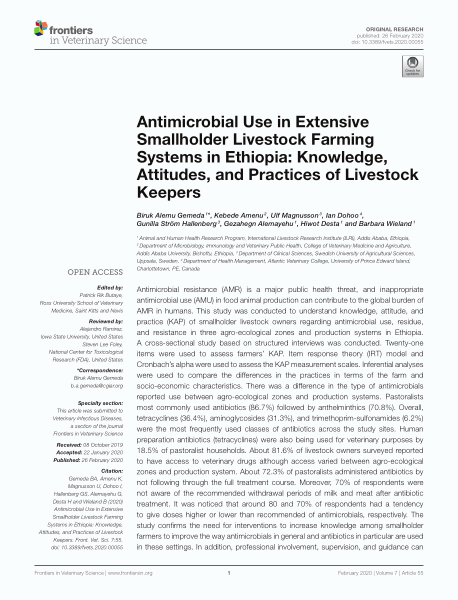Antimicrobial use in extensive smallholder livestock farming systems in Ethiopia: Knowledge, attitudes and practices of livestock keepers
Abstract
Antimicrobial resistance (AMR) is a major public health threat, and inappropriate antimicrobial use (AMU) in food animal production can contribute to the global burden of AMR in humans. This study was conducted to understand knowledge, attitude, and practice (KAP) of smallholder livestock owners regarding antimicrobial use, residue, and resistance in three agro-ecological zones and production systems in Ethiopia. A cross-sectional study based on structured interviews was conducted. Twenty-one items were used to assess farmers' KAP. Item response theory (IRT) model and Cronbach's alpha were used to assess the KAP measurement scales. Inferential analyses were used to compare the differences in the practices in terms of the farm and socio-economic characteristics. There was a difference in the type of antimicrobials reported use between agro-ecological zones and production systems. Pastoralists most commonly used antibiotics (86.7%) followed by anthelminthics (70.8%). Overall, tetracyclines (36.4%), aminoglycosides (31.3%), and trimethoprim-sulfonamides (6.2%) were the most frequently used classes of antibiotics across the study sites. Human preparation antibiotics (tetracyclines) were also being used for veterinary purposes by 18.5% of pastoralist households. About 81.6% of livestock owners surveyed reported to have access to veterinary drugs although access varied between agro-ecological zones and production system. About 72.3% of pastoralists administered antibiotics by not following through the full treatment course. Moreover, 70% of respondents were not aware of the recommended withdrawal periods of milk and meat after antibiotic treatment. It was noticed that around 80 and 70% of respondents had a tendency to give doses higher or lower than recommended of antimicrobials, respectively. The study confirms the need for interventions to increase knowledge among smallholder farmers to improve the way antimicrobials in general and antibiotics in particular are used in these settings. In addition, professional involvement, supervision, and guidance can also lead to more efficient antimicrobial use by smallholder livestock owners. The study also highlights the need for research into the development of usable tools that measure antibiotic knowledge and attitudes.

